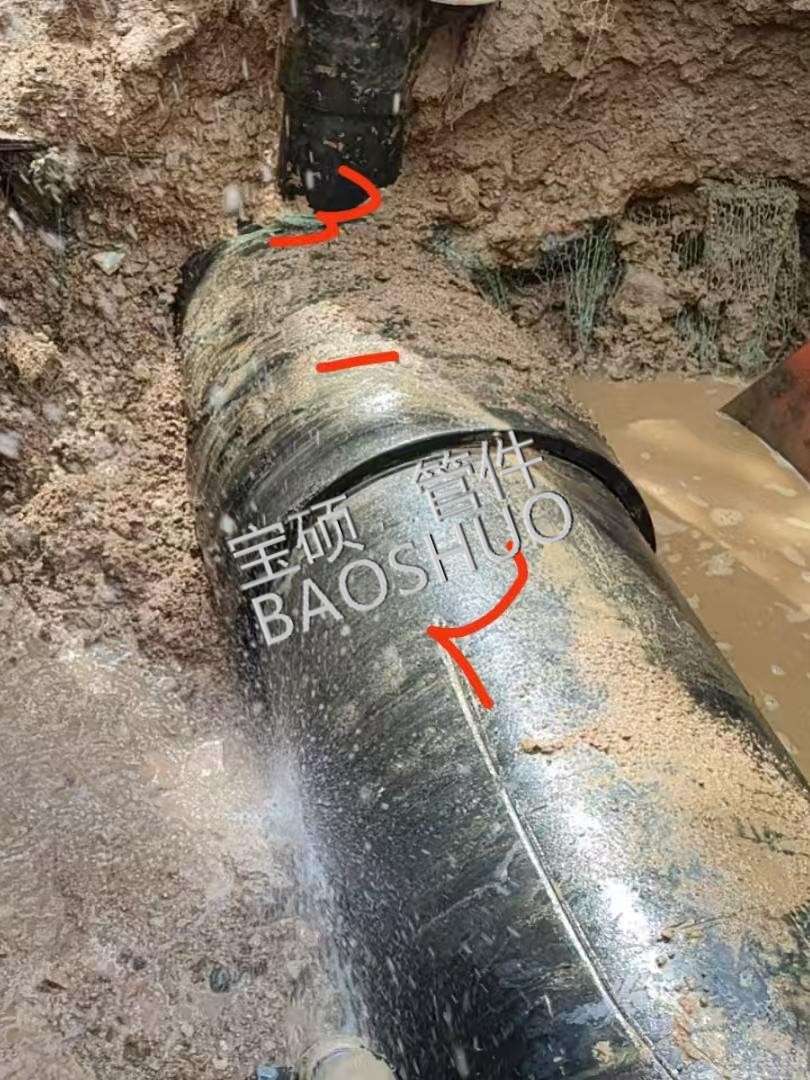Why is welding not recommended for DN1800 ductile iron pipe leakage? What repair methods are usually used?
🧿 The first is to stop water replacement。If conditions allow for a water outage, replacing the damaged pipe directly is a thorough solution. However, you must carefully consider the costs: the potential loss of water, the cost of purchasing new pipes, the labor costs of installation, and the cost of transporting the pipes to the site.
🧿The second is to use a special maintenance pipe clamp,This is also commonly known as a pipe repair clamp. The biggest advantage of this method is that it doesn't require water shutoff; repairs can be performed while the pipe is running and under pressure, and installation is also straightforward. Cost depends on the location of the leak: a straight pipe, a tee, an elbow, or a flange. Different locations require corresponding pipe repair clamps, and the price will vary. Add installation and shipping costs to the total cost.

Let's focus on why welding is not recommended. The risks of welding ductile iron pipes are mainly inseparable from its material properties and welding process issues.
From the material itself,Ductile iron contains significant amounts of carbon and silicon. During welding, the base metal melts into the weld, resulting in a high carbon equivalent in the weld metal—a detrimental issue. Furthermore, the area near the fusion line undergoes rapid heating and cooling during welding. This rapid heating and cooling can cause the structure in this area to become hard and brittle. This can lead to the formation of martensite, a hard, brittle, and easily cracked structure, or the development of white cast iron, which, like white cast iron, is too hard to machine and has extremely poor toughness.
In addition, the reason why ductile iron has good strength and toughness,It all depends on the spherical graphite inside. However, during welding, the graphite spheres near the fusion line in the heat-affected zone may partially dissolve or deform, thus reducing their original advantages. What's more troublesome is that the matrix structure near the fusion line will also become the brittle structure mentioned above. At the same time, the high carbon equivalent plus impurities such as sulfur and phosphorus will make the weld particularly prone to thermal cracking near the end of solidification; and the martensite in the weld and heat-affected zone is very sensitive to hydrogen embrittlement. The hydrogen that enters during welding accumulates in tiny defects during cooling, and coupled with residual tensile stress, it may take some time for cracks to appear, which is called cold cracking. In addition, the composition difference between the base material and the filler metal is large, and a hard and brittle transition layer is easily formed in the fusion zone, affecting the overall performance.
Let’s talk about the problem of thermal stress and deformation。Cast iron's thermal conductivity isn't very good, but its coefficient of linear expansion is quite high. The concentrated localized heating during welding, followed by rapid cooling, generates significant contraction stresses in the weld and heat-affected zone. However, cast iron itself has very poor plasticity, and cannot release these stresses through deformation. Consequently, the enormous residual tensile stresses acting on the already brittle and hardened heat-affected zone (HAZ) can easily cause cracking in the weld or HAZ. Cracks sometimes occur during welding, while others only appear after cooling or a period of storage. Furthermore, the localized heating and contraction can cause the pipe to bend and twist, resulting in uncontrollable deformation.
Therefore, the risks of ductile iron pipe welding,
The problem stems from a combination of three factors: structural embrittlement caused by the high carbon equivalent, significant residual welding stresses, and cast iron's inherently poor ductility, which prevents stress release. The resulting welded joints, especially the heat-affected zone, are often hard and brittle, prone to cracking, and significantly inferior to the original pipe's performance.
Unless standard connections are absolutely impossible or the repair is minor, with rigorous process assurance and testing, avoid welding. Even then, seek experienced welders and strictly adhere to specific welding specifications for ductile iron, including preheating, selecting the right welding consumables, controlling the process, and ensuring proper post-heating or heat treatment. For critical pressure piping, welding repair plans must undergo rigorous evaluation and approval.










